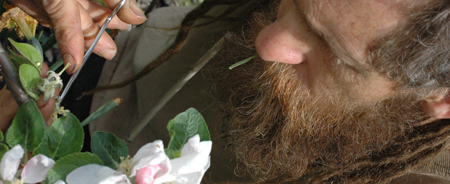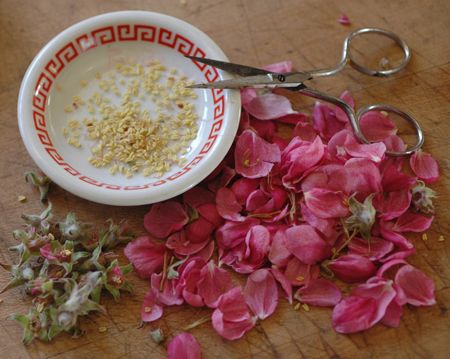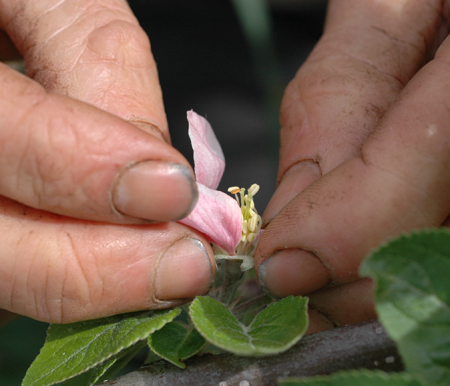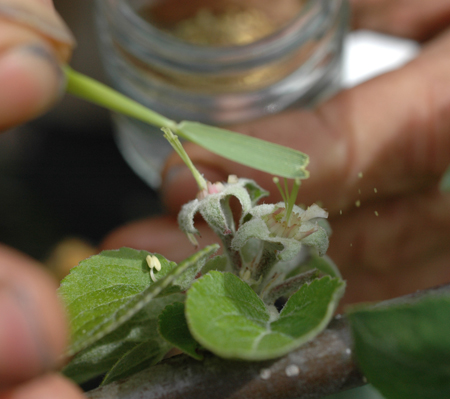 The awesome Photos of pollinating in this post are by tonia Chi
The awesome Photos of pollinating in this post are by tonia Chi
In part one I laid out some ideas and a little history toward the end of convincing you to try breeding new apples. Here I present the nitty gritty of pollinating the flowers and in Part 2 I'll cover growing the seeds out. Neither process is very difficult, nor particularly time consuming. Later on, grafting of the trees and growing them to fruition may require some skills that most people don't have, but those can be learned elsewhere, or may be covered in future posts here, so don't let that stop you.
SELECTING PARENTS: You can of course just plant some apple seeds from any apple you like, but the real fun is in selecting two apples that have something awesome about them and assisting them to procreate. Albert Etter’s success was based on extensive trials using over 500 varieties to find apples with the most promising characteristics to use as parents. In his own words....
"In selecting apples one has a double index to go by: he selects his mother variety and his "mother-apple" to take the seeds from. The immediate success, of my work may be attributed to the foundation I laid, and my ability to select the individual fruits that will develop superior progeny."
“I am sending a collection of some of my new varieties of apples... The whole problem is now as simple as breeding up a herd of good dairy cows when one has a good herd to begin with. “
“Some people wonder where it is possible to make any very decided Improvement over existing varieties of apples now in general cultivation. To my notion we have really only begun to improve the apple systematically. I admit I have opportunity to study first hand that which gives me an insight denied to others who think and work along other lines. Comparison is a wonderful means of discerning faint lines. By this simple mental process what seems as opaque as milk reveals lines of similarity undreamed of before."
Something else that interested Etter was taking chances on more primitive apples like crabs, and the red fleshed Surprise apple, to breed in exciting new characteristics. I would imagine that such a project can take a greater number of generations than working with more refined apples, but in his case it paid off. Fortunately, we can build on Etter's work. Wickson, which is probably destined to be Albert's most famous creation, is a case in point. It is a very small, and incredibly sweet, apple having unique and intense flavor coming from somewhere other than just the standard large varieties. Though newer apples seem to be diversifying, much of what has been done in breeding so far has been to try to improve on what people already considered to be a good, or archetypal, apple. We aren't in great need of any more of those! Apples with intense and diverse flavors, better textures over a greater range of seasons is something we can definitely use. I would say that instead of crossing apples that are just good, or even really good, cross apples that are really interesting. Not only will that give us interesting apples, but it just increases the chances that we will come up with something worth growing. If you come up with the most bubblegum flavoredest apple ever, then we'll all just have to grow it until a better bubblegum flavored apple comes along. If you're trying to grow a better Golden Delicious or Macintosh style apple, you're probably not going to compete with the many already released by all the advanced breeding programs out there.
My efforts select primarily for flavor and internal color, with keeping ability nudging in as an important third priority, though I'm also interested in better early apples. All of my crosses so far have been using Albert Etter’s red fleshed apple varieties as one parent, combined with other apples that I think are awesome.
I would encourage you to work only with apples that really inspire you. If you don't have any, consider collecting some. At the simplest, just take two awesome apples and rub their stuff together. It doesn't have to be that simple though. Some traits are dominant and some recessive. Dominant traits will express in the offspring even if only one parent carries that gene. Recessive traits will only express if both parents carry the gene. It only gets more complicated from there and I've yet to find and assimilate much of that information. The truth is that I'm dragging you with me down the path of apple breeding with very little of that knowledge. The only thing I know at this point is that the red flesh gene is dominant. So, I cross red fleshed apples in both directions. I also read something indicating that a columnar habit of the tree is dominant (columnar trees have few if any side branches, having instead single upright trunks). If anyone out there knows more about dominant and recessive apple traits, post something in the comments, or email me. I've looked for a simple list, or short treatment of dominant and recessive traits, but have yet to find one. For more on plant breeding on an amateur scale, including basic genetics, see Carol Deppe's cool book Breed Your Own Vegetable Varieties. (Carole Deppe is awesome and a huge cut above the average garden writer. Her book The Resilient Gardener is a must read for homesteader types.)
One thing you can pay attention to is who the parents of apples you like are and consider going back to one of those or using other apples which are the offspring of those same parents. If the parents are known, that information is not usually difficult to find. For instance, at least two promising apples here have Northern Spy as a parent. While I'm likely to use the offspring, I also may end up going back to the source.
(I edited out a section of the original post here misinforming people that patent law extends to pollen. I'm not totally clear on this, but I don't think it does in the case of vegetatively propagated plants)
A few apples, known as triploids, have sterile pollen. Although triploids cannot be used as pollen doners, they can be fertilized with pollen from another tree, so look up the apples you want to work with and if one is a sterile triploid, use it as the seed parent and not as the pollen parent. I can't find a full list of triploids anywhere, but if you google the name of the apple with the word triploid, you'll probably find out if it's a triploid easily enough... that's what I do anyway. Triploids are uncommon, but some popular and excellent apples are included in the group, such as: Orleans Reinette, Roxbury Russet, Ashmead’s Kernel, Suntan, Belle de Boskoop, Arkansas Black, Baldwin, Bramley’s Seedling, , Gravenstein, Holstein, Jonagold, Jupiter, Lady, McIntosh, Reinette du Canada, Rhode Island Greening, Ribston Pippin, Spigold, Stayman Winesap, Suntan and King of Tompkin's County. I've had some trouble pollinating triploids and getting their seeds to grow, but will continue trying.
NIGEL DEACON: I first learned how to pollinate apples from Nigel Deacon in the U.K. Who is also attempting to breed red fleshed apples. He cuts off the calyx with a special pair of scissors removing the pollen bearing anthers in one snip. Nigel’s method is very fast, but the apples grown after pollinating are sometimes slightly deformed due to the missing calyx. I prefer to remove the petals and anthers carefully with fingers and scissors. My method is slower, but leaves the apple to grow normally. I’m not sure one way or the other is really better, but I tend to subscribe to the idea that healthy plants make the best seed doners. Genetic coding is one factor in what a plant turns out like, but it is not set in stone and good genes are better expressed in healthy plants from healthy parents, so I err on the side of caution, even though if I had to guess I'd say it's probably not very relevant.
BALLOON STAGE: Apple blossoms are pollinated when they are in what is called the balloon stage. At this stage, the female parts of the flower in the unopened petals are already receptive to pollen, but insects can’t reach them to pollinate. At the same time, the Anthers, or boy parts, on which the pollen is produced, have not made any pollen yet, so the flower cannot have self pollinated either. If you open the virginal flower, you can pollinate it manually and remove all the anthers before they bear pollen, thus assuring that it is your chosen parent which fertilizes the flower. The balloon stage is when the flowers are blown up like a balloon and look like they will open in the next day or so. Look at a few clusters of flowers. If some are open and others are not, the best ones to open and pollinate are the ones with the biggest balloons. You can often pollinate over a couple of weeks, but it is best to pollinate earlier than to wait till later when there are only a few blossoms left.
COLLECTING POLLEN: Pollen must be collected a day or two before pollinating so that the anthers have time to dry and release the pollen. Open some flowers of the variety that you want to collect pollen from by carefully pinching away the petals. The pollen is made by the Anthers, which grow around the edge of the flower on little stalks. The 5 delicate center stalks are the female parts, which you can ignore for now unless you are pollinating the same flower that you gather pollen from. In fact, it is easier to just clip them off with the anthers when you are gathering pollen than it is to try avoiding them. The anthers will not have any pollen on them yet, but they will finish making pollen as they dry. Trim off the anthers into a small container with a sharp pointed pair of small scissors. Nigel Deacon uses a hair comb to comb them off. The anthers produce a small amount of pollen only. You don’t need a lot to do just a few pollinations, but collect anthers from at least 6 to 10 flowers or so. Allow the anthers to dry in a warm room until the pollen powders out. Nigel says the pollen can be stored for up to 3 years if kept very dessicated, but I haven’t tried that yet.
POLLINATING: The best time to pollinate is on a warm sunny day in mid morning to early afternoon, but just do it whenever you can make time. To pollinate a flower, pinch off any in the cluster that are open and any that are small leaving just 2 or 3 large balloon stage buds.
Carefully pinch or trim away the petals of the remaining flower buds.
With sharp pointed scissors, trim away the anthers around the outside edge of the flower, leaving the 5 center female "pistles" untouched. There are 5 five pistles coming out of the center of the flower and each one communicates to what will be one of the five seed cells in the mature apple. If any of these is damaged, use a different flower if you can. You may still get some seeds, but the tree is more likely to reject a partially fertilized apple.
Once all the anthers are removed, apply some pollen to the female parts. Use a piece of grass blade, a fine tiny paint brush, a glass rod, or even the tip of a finger. There is a slightly sticky tip on the pistle called the Stigma. Pollen will stick to the stigma easily.
You can see when the flower is well pollinated, because the stigma will have pollen stuck to it, but your odds will probably increase if you visit the flower again for a second pollinating the next day. I don't usually do so and seem to do Ok, although it is not uncommon to find only a few seeds in an apple. Triploids can be troublesome, so it might be well to visit them again. I've had poor luck with pollinating Suntan, a triploid, and even poorer luck growing out the few seeds I've managed to get from it.
BTW: I have a TERRIBLE time remembering the names of all these flower parts for some reason and am constantly looking them up again. It doesn't really matter though, just remember: girl parts in the middle need pollinating and boy parts on the outside need removing.
BAGGING V.S. NOT BAGGING: To be as sure as possible that the flowers you've chosen to pollinate are not pollinated with undesirable pollen by bees and other insects, you would have to bag the blossoms, or cage the tree. I choose not to. My rationale is that since the petals are removed, there is little to draw insects to the flower. Also, by that time I've already pollinated the blossom and the stigma should be crusted with pollen of my choosing. At worst a few of the seeds in the apple might receive some random pollen, but it seems unlikely, therefore I choose not to bother bagging because it would just increase the effort spent for a small degree of insurance.
LABELING: Always label! tie a marker around the flower cluster so you can identify it later, because all the other apples will look just the same. Only the genetic information in the seeds is different, while the fruit will look the same as the other fruit on the tree. I use neon colored plastic strips so they are easy to find later. Be sure to write what the crosses are on the tag with permanent marker. When the apples get to be about half grown, I actually write on the apple with a permanent marker so that if it is knocked off by birds or wind, I can identify that it is an apple which I pollinated, and which cross it is. The convention for writing crosses is Seed Parent X Pollen Parent.
The next post will be on growing out the seedlings, and someday I'll write about something besides apples again! promise...












